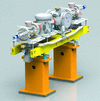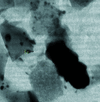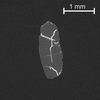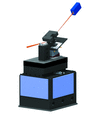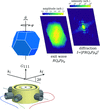issue contents
September 2019 issue

Cover illustration: A broad outline of the global network skeleton map and HE staining slices versus 3D virtual images by synchrotron radiation phase contrast imaging in the mouse brain (see Shi, Zhang, Yin, Wang, Tang, Luo, Ding, Chen, Cao, Wang, Xiao and Zhang (see pages 1742-1750).
facility information
research papers
Detectors based on microchannel plates (MCPs) are used to detect free-electron laser radiation. Three MCP detectors have been developed by JINR for the European XFEL (SASE1, SASE2 and SASE3 lines).
A hybrid focusing system in combination with a Kirkpatrick–Baez mirror system and an ellipsoidal mirror has been developed to produce a sub-micrometre focus for soft X-ray free-electron lasers with an extreme power density beyond 1016 W cm−2.
The feasibility is explored of resolving ultrafast fragmentation of liquids at the nanoscale with single-shot small-angle X-ray scattering on the basis of large-scale molecular dynamics simulations. From the simulated SAXS patterns, particle-volume size distributions are obtained with the regularization method and average particle sizes with the weighted Guinier method, at different expansion rates.
Monitoring the photon pulses generated by the European XFEL is essential for its startup and operation. The X-ray diagnostics system and commissioning results are described with an emphasis on the hard X-ray SASE1 beamline, which was commissioned first.
Open  access
access
 access
accessThe Femtosecond X-ray Experiments scientific instrument is a versatile instrument for ultrafast pump–probe X-ray absorption, emission and scattering experiments at the European XFEL; the instrumentation, commissioning results and operation performance status are presented.
Karabo, a new distributed control software developed at the European XFEL, is presented.
The present work reports on the final results of the upgraded Kirkpatrick–Baez active optics systems (KAOS), which have been mechanically modified in order to work with better stability and repeatability with respect to the original design. The results have been obtained on both the FERMI FEL lines, FEL1 and FEL2, and are particularly relevant for the latter as it is the low-wavelength line recently opened to users.
Open  access
access
 access
accessA novel method is proposed to create three-color free-electron laser pulses based on high-gain harmonic generation with a tilted electron bunch which is created by a corrugated structure, a drift section and a quadrupole. Theoretical analyses and numerical simulations confirm the validity and feasibility of this scheme both for the TGU radiator and the natural gradient in the extreme-ultraviolet waveband.
Accurate and simple-to-compute analytical formulation for the effect of the high undulator field harmonics on spontaneous and stimulated undulator radiation is provided. It is applicable to any undulator and confirmed by comparison with LCLS and SPring-8 FEL experiments and with SPECTRA numerical simulations.
Photon diagnostic imagers provide information on the X-ray free-electron laser beam along the photon-transport path from the undulators up to the scientific instruments.
A channel-cut Si(111) crystal X-ray monochromator with a channel width of 90 µm was developed for achieving reflection self-seeding in hard X-ray free-electron lasers. A high conversion efficiency of a monochromatic seed from a broadband X-ray beam was experimentally evaluated to be 2 × 10–2 with a small optical delay of 119 fs at 10 keV.
Focusing of a Gaussian beam through an elliptical mirror is addressed. Focus shifts induced by displacements of the source longitudinal position and pointing, then amplified by mirror surface defects, are investigated.
Open  access
access
 access
accessThe novel line detector KALYPSO has been developed for the measurement of one-dimensional profiles at high-repetition-rate free-electron lasers (FELs) and synchrotron radiation facilities. The current version has 256 pixels with a continuous data readout at a maximum frame rate of 2.7 MHz. At FLASH, KALYPSO has been utilized as photon diagnostics for monitoring pulse-resolved FEL spectra at a repetition rate of 1.0 MHz. KALYPSO is a collaborative effort between the Karlsruhe Institute of Technology (KIT), Paul Scherrer Institut (PSI), Lodz University of Technology (TUL-DMCS) and Deutsches Elektronen-Synchrotron (DESY).
The feasibility of laser-slicing at a diffraction-limited light source is investigated through analytical and numerical models, including electron and radiation beam simulations.
A new design for a high-efficiency multilayer-coated blazed X-ray grating with horizontal-shifted (non-conformal) boundary profiles is proposed. This work shows that the diffraction efficiency of the blazed gratings with shifted boundary profiles is substantially higher than the efficiency of gratings with conformal boundaries, which are, moreover, much more difficult to produce.
Open  access
access
 access
accessAn X-ray beam monitor operating in parallel to experiments and adapted to the moderate flux density as well as rather large beam diameter of inverse Compton sources is presented. In conjunction with this device a closed-loop feedback system was developed counteracting the recorded source position drifts and thereby significantly improving the X-ray source position stability.
Diamond lenses for hard X-ray microscopy were fabricated by e-beam lithography and subsequent deep reactive ion etching. The optics focus hard X-rays (24.3 keV) to a lateral spot size of 360 nm.
Soft X-ray and vacuum ultraviolet (XUV) optical systems are widely used with synchrotron radiation, X-ray microscopy, etc. Here an aberrations analytical analysis method for XUV multi-element optical systems is proposed. It can calculate the contribution of different types of aberration, and thus will be helpful in the design and optimization of XUV multi-element optical systems.
An investigation of the soldering of silicon to Invar using tin alloys for double-crystal monochromators is presented.
Open  access
access
 access
accessAn X-ray amplitude-splitting interferometer based on compound refractive lenses, which operates in the reflection mode, is proposed and realized.
The idea to split a mixed beam of soft X-rays and hard X-rays on the same axis into different directions is presented. This will be useful in the design of two-colour beamlines.
It is shown that the operation of second-order diffraction in blazed gratings with smaller groove densities for the soft X-ray range can be used for scanning to higher photon energies, which might otherwise not be available or may require the use of a higher-density grating.
The capability to perform high-pressure low-temperature nuclear inelastic scattering with a sapphire backscattering monochromator is reported, and it is applied to obtain the density of phonon states of TeO2 at pressures up to 10 GPa and temperatures down to 25 K.
Open  access
access
 access
accessPorous, high-surface-area electrode architectures are described that allow structural characterization of interfacial ultra-thin catalyst films under device-relevant functional electrochemical conditions using high-energy X-ray (>50 keV) scattering and pair distribution function analysis.
Determination of the lattice parameters, unit-cell orientation and structure factors of SrLaAlO4 crystal by means of energy-dispersive X-ray Laue diffraction using ultra-high X-ray synchrotron radiation and 2D energy-dispersive detector.
The first analytical dead-time models have been developed that offer a realistic description of dead-time effects on the photon-counting rates of modern pixel detectors with constant current discharge (e.g. the Medipix and CPix families of detectors), using realistic models for the analog preamplifier circuits in pixels. Measurements with existing detectors with at least two thresholds and corresponding counters can now be linearized without calibration or knowledge of the detector and beam parameters (dead-time behavior, integration time, fill pattern), enabling linear counting rates of 107 photons per pixel per second with minimal increase in noise.
A fast X-ray imaging detector based on a long-working-distance optical coupling system is reported. Test results show that the detector realized fast X-ray imaging with a frame rate of 100000 frames s−1 and fast X-ray microtomography with a temporal sampling rate up to 25 Hz (25 tomograms s−1).
A weighted parametric Rietveld refinement technique for revealing subtle phase boundaries is outlined.
The first results of the dynamics of diffraction peak-shape measurements during pulsed heat load are presented. The experiment is aimed at the development of in situ diagnostics of the depth distribution of deformations in a single crystal.
The X-ray integer and fractional Talbot effect is studied under two-wave dynamical diffraction conditions in a perfect crystal, for the symmetrical Laue case of diffraction. The dynamical diffraction fractional Talbot effect is investigated for the first time.
Open  access
access
 access
accessThe time-resolved X-ray diffraction technique is proposed to characterize the fatigue behavior of metallic materials during ultrasonic cyclic loading.
The sequence of formation of metastable and basic phases in the process of self-propagating high-temperature synthesis of mechanoactivated non-irradiated and mechanically activated γ-irradiated powder mixture (Ti 64 wt% + Al) composition is established using in situ synchrotron studies.
X-ray fluorescence microscopy and micro-X-ray absorption spectroscopy were used to investigate the composition and distribution of tarnish formed on 19th century daguerreotypes, the first form of the photographic image.
The correlation between V valence state and epitaxial strain has been observed for cation-deficient Sr1–yVO3 ultrathin films and it is found that a variation in V valence state is only observed for tensile-strained films. SrVO3 thin films are metallic and exhibit a thickness-driven metal–insulator transition at different critical thicknesses for tensile and compressive strains.
The combination of multiple scientific software packages to predict new physical properties is becoming very common, taking advantage of the strengths of each package without having to re-implement complex algorithms. Corvus is a Python-based package designed for managing these complex workflows of physical simulations, bridging the gaps between scientific software packages.
PHYSICS | FELS
It is demonstrated that small errors in the photon statistics of a photon-counting area detector can be identified and corrected for. This is of crucial importance for low-count-rate X-ray speckle visibility experiments where the photon statistics of coherent scattering images are characterized to obtain information about the sample's dynamics.
It is demonstrated that X-ray absorption spectroscopy, both XANES and EXAFS, of solutions with millimolar concentrations of metal is possible using the femtosecond X-ray pulses from XFELs with two different sample delivery methods, a Rayleigh jet and a drop-on-demand setup.
Recent instrumental developments implemented at beamline ID20 of the ESRF that allow high-pressure low-temperature resonant inelastic X-ray scattering measurements to be performed are described. The high-pressure magnetic structure and dynamics of the bilayer perovskite iridate Sr3Ir2O7 is presented and discussed.
X-ray absorption fine-structure (XAFS) spectra of ThF4–LiF–BeF2 at room temperature, 600°C, 700°C and 800°C were obtained for the first time. The structural differences between ThF4–LiF and ThF4–LiF–BeF2 mixtures in the molten and solid phases were compared to understand the behaviors of thorium ions and the transport properties in the fluoride media through experimental and theoretical XAFS analysis combined with molecular-dynamics simulations.
A synchrotron-radiation-based propagation phase-contrast imaging approach is presented for visualizing the three-dimentional angioarchitecture of a mouse brain at ultrahigh resolution without any contrast agent.
Open  access
access
 access
accessX-ray ptychography was optimized at energies of 17 and 33.6 keV at the ESRF using Kirkpatrick–Baez mirrors.
Open  access
access
 access
accessMicroinclusions in diamond reveal geochemical signatures from the Earth's deep mantle. A methodology is developed for non-destructive, high-throughput in situ characterization of mineral inclusions using synchrotron X-ray microtomography, radiography and diffraction at GSECARS, Sector 13 of the Advanced Photon Source.
Open  access
access
 access
accessA series of nanoreactors have been developed for complementary in situ X-ray and electron microscopy. The setup was utilized to monitor thermal annealing processes of porous materials under controlled atmospheres with hard X-ray ptychography.
Open  access
access
 access
accessA method comprising near-field holography with an electron beam lithography-written phase mask was developed herein. Soft X-ray varied-line-spacing gratings with a central groove density greater than 3000 lines mm−1 were fabricated using this method.
Open  access
access
 access
accessA multimodal imaging instrument has been developed that integrates scanning near-field optical microscopy with nanofocused X-ray diffraction imaging. The instrument allows for simultaneous, site-correlated characterizations of electronic and near-field optical properties of materials together with their crystallographic structure with nanoscale resolutions.
In-house-developed flame-retardant rigid polyurethane foam was exposed to gamma irradiation doses in the 0–20 kGy range and synchrotron X-ray computed tomography was employed for the analysis of radiation-induced morphological variations in their cellular microstructure.
An accurate and efficient method for jitter correction in transmission X-ray microscopy is presented.
short communications
A sample delivery method using viscous media, a syringe and a syringe pump for serial crystallography is presented.
Open  access
access
 access
accessA new approach for efficiently loading fixed targets for serial crystallography using acoustic dispensing is presented.
A novel method is introduced for measuring the focal point of a sagittally bent Laue crystal monochromator using a multi-hole array.
Open  access
access
 access
accessCoherent imaging in the Bragg geometry of nanoparticles inside an electrochemical cell is presented.
beamlines
A beamline design that produces micro-scale beams from a bending magnet without significant flux loss through apertures is presented. An optical study based on this design is detailed, for tender X-rays spectroscopy, including conventional XAFS, scanning micro-XAFS and full-field nano-XAFS, with flux of the order of 1012 photons s−1.
teaching and education
Free 

BioStruct-Africa has been working to bridge the technology gap through capacity building for Africa-based researchers in structural biology.


 journal menu
journal menu




















